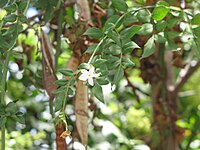
Bottom‐up and top‐down effects of tree species diversity on leaf insect herbivory
Sign Up to like & getrecommendations! Published in 2017 at "Ecology and Evolution"
DOI: 10.1002/ece3.2950
Abstract: Abstract The diversity of plant neighbors commonly results in direct, bottom‐up effects on herbivore ability to locate their host, and in indirect effects on herbivores involving changes in plant traits and a top‐down control by… read more here.
Keywords: bottom top; diversity; herbivory; neighbor identity ... See more keywords

Weak latitudinal gradients in insect herbivory for dominant rangeland grasses of North America
Sign Up to like & getrecommendations! Published in 2020 at "Ecology and Evolution"
DOI: 10.1002/ece3.6374
Abstract: Abstract Patterns of insect herbivory may follow predictable geographical gradients, with greater herbivory at low latitudes. However, biogeographic studies of insect herbivory often do not account for multiple abiotic factors (e.g., precipitation and soil nutrients)… read more here.
Keywords: latitudinal gradients; herbivory; insect herbivory; grass species ... See more keywords

Impact of Soil Rhizobacteria Inoculation and Leaf-Chewing Insect Herbivory on Mentha piperita Leaf Secondary Metabolites
Sign Up to like & getrecommendations! Published in 2020 at "Journal of Chemical Ecology"
DOI: 10.1007/s10886-020-01193-3
Abstract: Secondary metabolites commonly play important physiological roles in plants and can be modified quantitatively and qualitatively by exposure to biotic and abiotic interactions. Plant growth promoting rhizobacteria (PGPR) and herbivory induce systemic resistance. In the… read more here.
Keywords: insects; herbivory; chewing insect; insect herbivory ... See more keywords

Insect Herbivory Selects for Volatile-Mediated Plant-Plant Communication
Sign Up to like & getrecommendations! Published in 2019 at "Current Biology"
DOI: 10.1016/j.cub.2019.08.011
Abstract: Plant volatile organic compounds (VOCs) are major vehicles of information transfer between organisms and mediate many ecological interactions [1-3]. Altering VOC emission in response to herbivore damage has been hypothesized to be adaptive, as it… read more here.
Keywords: information; plant; communication; insect herbivory ... See more keywords

Warming alters sex-specific responses in leaf defense against insect herbivory in Populus cathayana
Sign Up to like & getrecommendations! Published in 2021 at "Environmental and Experimental Botany"
DOI: 10.1016/j.envexpbot.2021.104557
Abstract: Abstract Climate warming has been found to increase forest insect herbivory with potentially important consequences for the performance and distribution of plant species. Dioecious species often show sex-specific responses to abiotic drivers leading to spatial… read more here.
Keywords: insect herbivory; sex specific; defense; specific responses ... See more keywords

Tree diversity effects on leaf insect damage on pedunculate oak: The role of landscape context and forest stratum
Sign Up to like & getrecommendations! Published in 2019 at "Forest Ecology and Management"
DOI: 10.1016/j.foreco.2018.11.014
Abstract: Abstract Tree diversity has long been recognized as a major driver of insect herbivory in forest ecosystems. However, predicting the strength and direction of tree diversity effects in real-world situations has proven elusive. One likely… read more here.
Keywords: insect herbivory; diversity effects; tree diversity; stratum ... See more keywords

Doubling of biomass production in European boreal forest trees by a four-year suppression of background insect herbivory
Sign Up to like & getrecommendations! Published in 2020 at "Forest Ecology and Management"
DOI: 10.1016/j.foreco.2020.117992
Abstract: Abstract Background insect herbivory, i.e. the minor but chronic plant damage caused by insects, is usually considered ‘negligible’ for plants when compared with the severe defoliation associated with forest pest outbreaks. We experimentally tested the… read more here.
Keywords: insects; biomass; herbivory; background insect ... See more keywords

Insect herbivory dampens Subarctic birch forest C sink response to warming
Sign Up to like & getrecommendations! Published in 2020 at "Nature Communications"
DOI: 10.1038/s41467-020-16404-4
Abstract: Climate warming is anticipated to make high latitude ecosystems stronger C sinks through increasing plant production. This effect might, however, be dampened by insect herbivores whose damage to plants at their background, non-outbreak densities may… read more here.
Keywords: subarctic birch; birch forest; plant; herbivory ... See more keywords

Tomato PEPR1 ORTHOLOG RECEPTOR-LIKE KINASE1 Regulates Responses to Systemin, Necrotrophic Fungi, and Insect Herbivory
Sign Up to like & getrecommendations! Published in 2018 at "Plant Cell"
DOI: 10.1105/tpc.17.00908
Abstract: PORK1 is identified and characterized as a receptor-like kinase involved in tomato responses to the endogenous peptide systemin. Endogenous peptides regulate plant immunity and growth. Systemin, a peptide specific to the Solanaceae, is known for… read more here.
Keywords: pepr1 ortholog; systemin; insect herbivory; tomato ... See more keywords